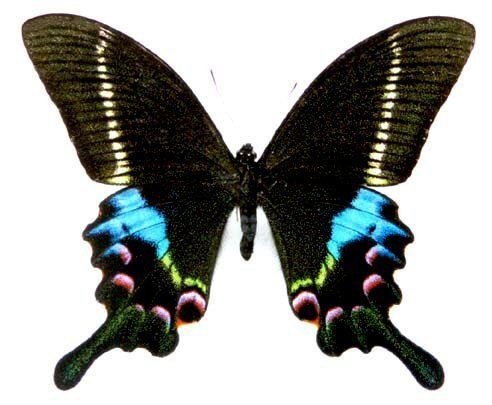Family Papilionidae | Genus Papilio Rank Species | |
 | ||
Similar Papilio arcturus, Papilio bootes, Papilio elephenor, Papilio alcmenor, Papilio fuelleborni | ||
Papilio krishna wmv
Papilio krishna, the Krishna peacock, is a large swallowtail butterfly found in forests in China, north east India, Myanmar and Vietnam.
Contents

Description

Resembles Papilio paris generally, but differs in many points as follows: Upperside: ground colour more of a brownish black, irrorated similarly to parti with, green scales, but the scales smaller and more sparsely spread. Forewing: the postdiscal transverse band well defined, complete, formed of white scaling with only a thin sprinkling of green scales on its inner margin, generally erect or slightly curved, rarely slightly sinuous. Hindwing: upper discal patch metallic greenish blue, smaller than in P. paris, but the portions of it in interspaces 6 and 7 more extended towards the termen, the metallic golden-green band that joins the patch on its inner side to the dorsal margin more conspicuous than in P. paris; the tornal ocellus as in P. paris, but above it a subterminal series of claret-red lunules in interspaces 2, 3, 4 and 5, followed by a series of ochraceous-red obscure terminal narrow lunules in the interspaces, the cilia on the outer margin of each conspicuously white. Underside: forewing as in P. paris but an erect ochraceous-white postdiscal band as on the upperside limits; the series of internervular pale streaks on the outer half of the wing. Hindwing: a well-defined discal ochraceous-white band formed of a series of somewhat lunular marks in the interspaces, these increase in width anteriorly; a subterminal series of claret-red lunules traversed by violet scaling on the inner side as in P. paris, but much broader and more prominent; finally a terminal series of ochraceous-yellow lunular marks in the interspaces; the cilia that border each lunule white. Antennae, head, thorax and abdomen as in P. paris.
Range
Sikkim, Bhutan, Darjeeling, Nagaland, Manipur, Myanmar and all around the Himalayas.
Status
The IUCN Red Data Book records the status of the Krishna peacock as uncommon. It is not known to be threatened, though like all peacocks, it is highly sought in trade.
Habitat
Generally found in the forests of the Himalayas where it flies from 3,000 to 9,000 feet (910 to 2,740 m).
Food plants
The following food plants from family Rutaceae have been recorded:
